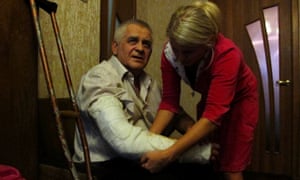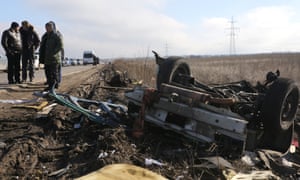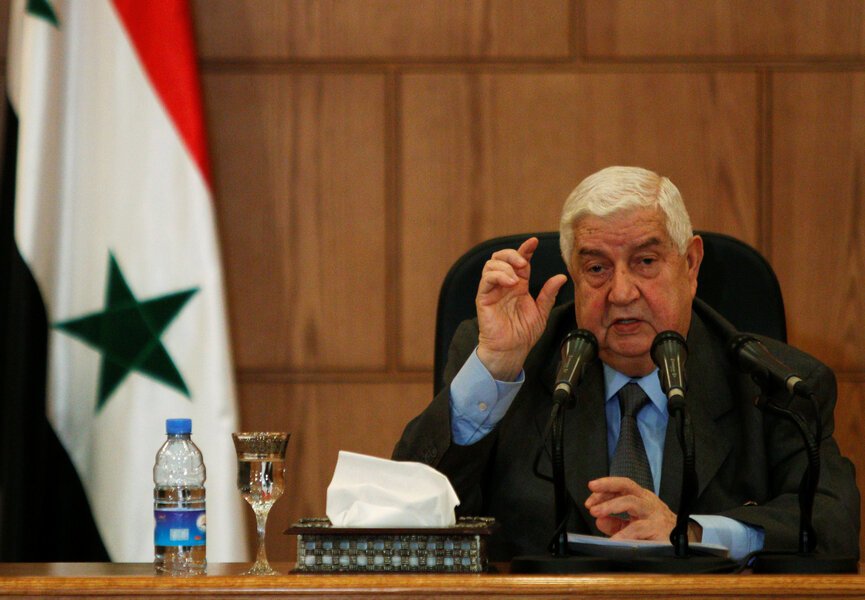Ukraine has launched an unprecedented operation in its war-torn east to defuse a landmine crisis, the scale of which is only now becoming apparent as former refugees try to reclaim their homes and return to work.
Although the country ratified the 1997 mine ban treaty, its armed forces and Russian-backed rebels have both made widespread use of their stockpiled, Soviet-made devices. The UN estimates that mines are strewn across at least 30,000 (74,000 acres) hectares of land, far beyond the reach of current clearance efforts.
Landmines and unexploded ordnance (UXO) have killed more than 600 soldiers and civilians, including dozens of children, and wounded more than 2,000 during almost two years of war. As the deadlock persists, these indiscriminate weapons now pose a greater risk to non-combatants than open warfare, causing about 80% of all Ukraine’s civilian casualties.
A truce helped diminish the new wave of artillery attacks that had erupted at the start of November, though fighting has again escalated in certain pockets of the front. Military commanders are exploiting periodic lulls to deploy taskforces of sappers to remove mines, UXO and booby traps throughout the “grey zone” – the battle-scarred land in limbo that straddles sovereign Ukraine and rebel-held territory.
Squads of deminers now face years of dangerous work as they spearhead Ukraine’s intensified mine-clearance programme, even while their fellow soldiers continue to plant the deadly devices elsewhere to defend their positions along the volatile contact line.
“Sappers make two mistakes in life,” joked Igor Byrukov, an officer supervising an early morning operation outside the strategic port city of Mariupol. “First, marriage. Second, stepping on a mine.”
In the expanse of field beyond, a trio of mine-clearers prodded the earth with poles; power lines above had rendered their antiquated sensors useless – a predictable headache for the men of Ukraine’s ramshackle army. Of particular concern were anti-personnel OZM-72s, which spring into the air and explode when a wire is tripped. Another device is dubbed the “black widow” – “very effective at tearing apart bone and flesh”, Byrukov explained.
Among the men was a young sapper called Alexey. Before the treacherous mission, the 22-year-old had tucked a photo of his family inside his flak jacket and positioned it over his heart. “I used to be scared every time,” said the father-of-one. “Now I feel no fear – it’s just a regular job.”
Another, Yuriy, 43, had lost count of the dozens of dangerous mine-clearance operations he had undertaken, and attributed his survival to the crucifix around his neck. He insisted that mines should now be banned. “At the very least, they must be a last resort,” Yuriy sighed.
The sappers’ superior, Oleksandr, 45, looked on from the field’s edge as his men delicately rooted around the fertile, black soil for explosive remnants. “We’re ramping up our operations while the ceasefire lasts,” he said. “But the job will last for years. There’s a big mess to clean up.”

Soldiers are not the only ones subjected to the horrifying impact of landmines – civilian casualties are common too. Gregory Voyevoda, 65, a veteran neurosurgeon, had resorted to farming wheat to supplement his meagre salary despite his high level of education. During a pause in hostilities last September, the grandfather returned to harvest his small patch of land near the front and was critically injured when his tractor triggered an anti-tank mine.
“I heard a click and instantly knew something was wrong,” Voyevoda said. “I opened the door to jump out but it was too late.”
The powerful explosion inflicted second- and third-degree burns down his lower body, shredded the muscles in his right forearm, shattered the bones in his feet and pumped his legs full of shrapnel. He spent 10 weeks in hospital before returning to his cramped, Soviet-era flat in Mariupol, where his daughter dresses his agonising wounds daily.
Despite the horror, he holds no grudge against the soldier who laid the landmine, nor does he agree with those who say the weapons should be banned. “War is war,” he said. “All our factories can be destroyed and rebuilt. All our men can be killed and women will give birth again. Our land, though, can never be replaced. You must use anything to protect it.”
Children are at particular risk from the devices, which may be brightly coloured, mistaken for toys and small enough to pick up or kick around. However, Unicef says there is no proper system for tracking the number of children killed and maimed in eastern Ukraine’s minefields, and has criticised the country’s health ministry for providing “unrealistic figures” on child casualties.
A recent report by Human Rights Watch revealed that hundreds of schools in eastern Ukraine had been attacked or occupied by one of the warring parties. It described how HRW researchers had discovered undetonated landmines in the grounds of one school, apparently thrown off a supply truck while it was parked in the schoolyard.
In an interview with the Kiev Post, Zeljko Lezaja, a landmine expert with the International Committee of the Red Cross, said: “Mines don’t recognise ceasefires, they don’t recognise friends or enemies. It costs some $3 to produce a mine, but about $1,000 to clear one.”
In February, four civilians were killed near Donetsk when a minivan transporting them from separatist-held territory tried to jump a checkpoint queue by pulling on to the verge and drove over a landmine.
Sappers in Ukraine have so far destroyed around 49,000 explosives, according to official figures, although both foreign monitors and the warring sides struggle to estimate how many remain. Victim-activated booby-traps have been used throughout the conflict zone despite being outlawed by the 1997 treaty, which came into effect in 1999.
Edward Crowther, of the Danish Demining Group, which is urging a coordinated, international response to Ukraine’s landmine crisis, said one problem was a lack of hard data about the scale of the problem. “It’s clear that these devices have been heavily used up and down the contact line,” he said. “As the conflict slips into a frozen phase and people attempt to return home to assess the damage and resume their lives, it’s likely that there will be a spike in casualties.”





